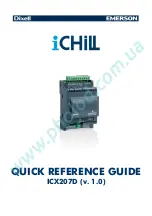
Central Interrupt Module (CIM)
507
SNIU028A – February 2016 – Revised April 2016
Copyright © 2016, Texas Instruments Incorporated
Control System Module
#pragma INTERRUPT(fast_interrupt,FIQ)
void fast_interrupt(void)
{
register int32 fiq_number, interrupt_bits;
volatile Uint32 read_scrap;
fiq_number = CimRegs.FIQIVEC.all; // Clear on read
if(fiq_number == 25) // Analog comparator interrupt and more
{
interrupt_bits = FaultMuxRegs.FAULTMUXINTSTAT.all; // Clear on read
if(interrupt_bits & 8) //if Iout1 is high (ACOMP-3)
{
output_over_current_protection();
}
if(interrupt_bits & 4) //if vout1 is high (ACOMP-2)
{
output_over_voltage_protection();
}
}
else if(fiq_number == 27) //DPWM3 interrupt
{
// To do
}
else if(fiq_number == 30) // Fault Pin Interrupt
{
if(interrupt_bits & 0x100) // If FAULT0
{
// To do
}
if(interrupt_bits & 0x200) // If FAULT1
{
// To do
}
}
read_scrap = Dpwm3Regs.DPWMINT.bit.PRD;
}
Since multiple interrupt sources are mapped toward a single ISR (interrupt service routine), the first thing
in the ISR should determine which source triggered the entrance to the current execution of ISR.
This can be done first by reading the CimRegs.FIQIVEC register. It is worth noting that the value of
CimRegs.FIQIVEC is read just once and saved into the temporary variable fiq_number. The program
should follow this format and should not read the CimRegs.FIQIVEC repeatedly in the else if statements.
This is mostly because CimRegs.FIQIVEC is a clear on read register, therefore only the first read attempt
per ISR of this register can be used to read intact and relevant values of all relevant bits.
The same is true about FaultMuxRegs.FAULTMUXINTSTAT, this is clear on read register as well.
Therefore same technique should be used to read its value.
NOTE:
In UCD3138 the interrupt flags need to be cleared by software and are not automatically
cleared by hardware.
In some other microcontrollers and microprocessors in the market the interrupt flags are cleared
automatically (by hardware) just before the ISR execution ends.
Since UCD3138 does not clear the interrupt flags automatically, this should be done by the ISR routine.
Negligence to clear the relevant interrupt flag will cause immediate re-invocation of the ISR instantly after
previous ISR execution ended. Therefore the controller (ARM7) will be busy with exaction of the ISR and
will never have the chance to execute the background tasks such as PMBus communications in the main()
routine.
Once again since multiple interrupt sources are mapped to a single ISR (interrupt service routine), the
clearing of the relevant interrupt flag should be added to the related elseif() statement within the ISR.
















































